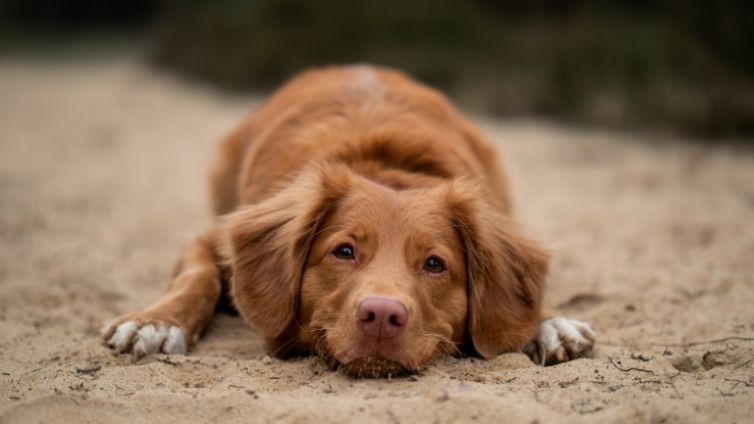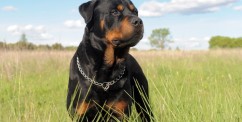Going to the beach with your dog is such a fun activity.
You get to bond, spend time together, play games, and swim together, or try some new activity that you both can enjoy, like kayaking.
This is, even more true if your dog is a naturally born water lover, such as Lagotto Romagnolo.
However, no matter how dreamy going to the beach with your dog sounds, certain things can make a day at the beach a real nightmare.
One of those situations include your Fido eating a hand full of sand.
Here is what you should know if your dog has eaten sand while exploring the beach area.
What If My Dog Eats Sand?
There is a thing called intestinal sand impaction. This is a specific condition that makes the dog very sick and is in a way is a potentially life-threatening condition.
You have never heard about it? Don’t be surprised, because many dog owners aren’t familiar with this term.
In a way, this is a good thing because it means that not a lot of dogs go through it.
On the other hand, the majority of dog owners are familiar with heatstroke, a more common condition that happens during summertime.
Heatstroke in short-faced breeds is more common than larger breeds with longer muzzles, while intestinal sand impacting can occur in any breed, anytime, and at any beach – all they need is a bit of sand.
Particles of sand are extremely tiny, so what is the issue you may think? Once they get wet, they become heavy. As such sand particles are heavy and they turn into a solid lump.
That being said, any sand that your dog swallows naturally becomes wet, and if he ingests a large amount of sand that amount becomes a real danger.
Important: Intestinal sand impaction refers not only to sand that a dog might swallow but to eating rocks as well.
Accidents happen. Dogs often accidentally or intentionally swallow sand. This simple action may lead to many not so simple outcomes.
Is sand something that dogs find delicious? Simply said, no.
Sand to dogs is usually just something strange that gets stuck on different items.
Here is how dogs most commonly ingest sand:
- Using their mouth to pick a toy from the ground
- Digging in sand
- Finding sand in most unusual places
- Licking up or eating sand after something spills on it
- Drinking water from various water sources
As you can see, sand ingestion can happen in most common situations and isn’t always something that can be easily controlled.
It’s very easy for sand to travel through the body. It’s most likely for small amounts of sand to pass through the GI tract without issue. However, when dogs (no matter their size) swallow a large amount of sand, it can cause impaction.
Impaction happens when the material compresses and forms a blockage in the intestines.
Symptoms Of Intestinal Sand Impaction
When a dog ingests sand you can tell by his behavior what’s happening.
Eating sand isn’t something that’s common for dogs, so as soon as he shows the following symptoms know that something is wrong:
- Vomiting
- Abdomen pain
- Constipation
- Loss of appetite
- Experiencing lethargy
Dogs cannot speak human. As such, they have to find a way to communicate with humans without using human words. The best way for them to communicate is to use their body language.
Dogs communicate with humans by using their body language. Throughout history, their brains evolved so much nearby humans that they learned how to use their bodies to communicate.
This went far much further from being able to communicate if they like food or not.
Over time, dogs learned to communicate more complex emotions using merely their body and their body’s reactions. Therefore, over time humans learned that dogs get sick just like humans do.
Also, dogs have learned that vomiting in dogs is quite similar to vomiting in humans.
The great thing about body reaction in dogs, and most stressful body symptoms is that signs of any disease may appear after only a few days.
In fact, in some cases, some symptoms may develop only a few hours after exposure to a couple of days later.
In other words, if your Fido starts showing any of the symptoms and you are at the beach the chances are that your dog ate some sand.
What should you do in this situation? If this occurs, you should see your veterinarian as soon as possible.
Seek Help
When soaked, the sand becomes heavy. As such it goes directly to the intestines, where the whole intestinal tract can easily shut down.
This means that neither water nor food would be able to pass to the stomach for digestion. Soon afterward, the dog will show signs of illness very quickly.
Once a dog eats sand, it’s just a matter of time when he will show signs of illness.
In most cases, he will show signs of illness quickly. Your dog will feel nauseous.
If your dog starts moving in circles and doesn’t seem to be comfortable with standing still, you should know that something is wrong.
Once your dog eats sand, you may notice your Fido being lethargic and refusing food.
Some dogs may experience panting, have sunken eyes, and a dry nose which are usually a sign that your dog is dehydrated.
This is why bringing water with you on the beach is so important.
As expected, when your dog dehydrates, a simple bottle of water won’t do much. However, monitoring your dog is what matters.
Did you know that there is a simple test that you can conduct to see if your dog needs fluids?
All that you have to do is to pinch a bit of loose skin slowly and gently lift it away from your dog’s body.
Let it go and carefully see how quickly the skin returns to its normal position. In healthy dogs, the skin will bounce back easily and quickly.
On the other hand, the dog who suffers from dehydration will react differently. In the dehydrated dog, the skin will seem to stick together, and very slowly return to the normal position.
The best way to know when something is wrong with your dog is to know your dog. This means that you can easily and fast recognize health-related symptoms in your pup.
Recognizing the symptoms listed above in your dog should be enough to know when to react. Noticing any of these symptoms is a clear sign that you should consult your veterinarian.
To determine what’s wrong with your Fido, the veterinarian will have to conduct certain tests. This will most certainly include X-rays and blood panels.
In this phase your dog’s health must improve hydration – therefore, intravenous fluid therapy is possible, while the next expected step could be surgery.
If sand is discovered in the dog’s gut the fluid theory should help pass what is stuck in the intestine.
In some cases, dogs may be given oils to help loosen the sand and help it pass.
As a general rule, synthetic sugar should help alleviate constipation, while in more severe cases veterinarians could perform surgery to remove (extract) a portion of the sane.
This isn’t something that can be done overnight: this is a weeks-long process.
It may take a few weeks to pass all the sand, and it’s not uncommon for the consumption of salt in the water may further complicate the situation.
Will your dog experience some disturbance during this process? Simply said, yes.
Passing the sand isn’t a comfortable experience, because the grittiness of the substance is unpleasant to discharge.
Top Beach Dangers for Dogs

Day at the beach is great as long as there are no accidents and unplanned moments.
Eating sand is just one of many unusual things that can happen while at the beach.
Here are additional beach dangers to dogs that can make a perfect beach day into a real disaster.
Salt Water
Dogs should always have drinking water in reach all year round. Just like humans, dogs love clean drinking water.
Still, that won’t stop them from tasting saltwater, especially if they are puppies and just exploring the world around them.
If your dog ingests a large amount of saltwater it can lead to salt toxicity, which is also known as hypernatremia.
While swimming, your dog can ingest a significant amount of water. A dog can ingest saltwater from chewing on toys that have been soaked from the sea.
Signs of salt toxicity are easy to spot, as they include:
- Vomiting
- Diarrhea
- Seizures
- Confusion
- Excessive thirst
Any of these symptoms can lead to coma if not treated right.
To avoid this situation and excessive drinking of saltwater, make sure that you have enough fresh water on hand.
It can also help to rinse them off before you leave the beach. This way you will remove any drops of seawater from their coat, that they can lick when licking their paws or any other body part.
Fish Hooks
It’s not very common for dogs to catch on fish hooks, but it can happen.
If you let your Fido swim in a popular fishing spot, you can expect fish hook-related accidents. How can this occur?
Even in the water, dogs will try to sniff around and explore anything unknown. This way they can easily come to various fishing hooks.
It takes a second for a dog to get attached to a hook. In fact, a hook will end up sticking in their mouth, stomach, throat, or even embedded in their skin.
What should you do if a dog swallows a fishhook? If this happened, the most important thing is to seek veterinary help immediately.
In moments like this, a second can be a make it or break it moment.
If the fish hook is stuck in the dog’s paw, or pierced through his lip, or stuck in any other place on the dog’s body, cover the area.
You can use a clean towel to do it. The goal here is to prevent the dog from grabbing the hook, licking it, or tugging it – you don’t want to let your dog worsen the situation.
Important:If there is a fishing line handing from dog’s mouth, its best not to try to remove it. Also, avoid pulling it because it can cause further injuries that you wish to avoid.
Puffer Fish
Pufferfish is packed with tetrodotoxin which is one of the world’s deadliest poisons, known to the human race.
This item is well spread across their skin and organs. Pufferfish is equally dangerous to humans and pets.
It’s common for people and pets to come across this fish the most during the spring and summer months. If you are based in a warm area all year round, then you and your dog are in bigger danger all year round.
If you know that your Fido, or yourself, can come in contact with this fish you should be ready to react to it.
Here are the most common symptoms that your dog can express:
- Vomiting
- Drooling
- Trembling
- Weakness
- Paralysis
- Breathing difficulty
The Bottom Line
Sand impaction can be real trouble if not treated on time. As a dog owner, you should think ahead and be ready for unplanned.
As a dog owner experiencing stressful situations is normal, because dogs have a mind of their own.
As such, they will sniff around, have a bit of almost anything – it’s just how they get familiar wuith the world around them.
Still, you should be watchful when it comes to new moments and new locations.
This applies to beach time as well. Be well prepared and do your best to react properly to unplanned moments. That being said, be mindful of possible beach danger.
Always have fresh water on you, provide enough shade for your canine, and be sure to react whenever you notice anything unusual in his behavior.
As long as you follow these steps and know how your dog behaves in general so you can recognize troublesome signs easily and faster.





















